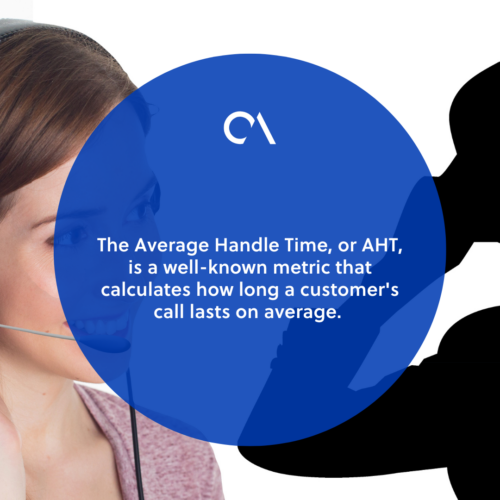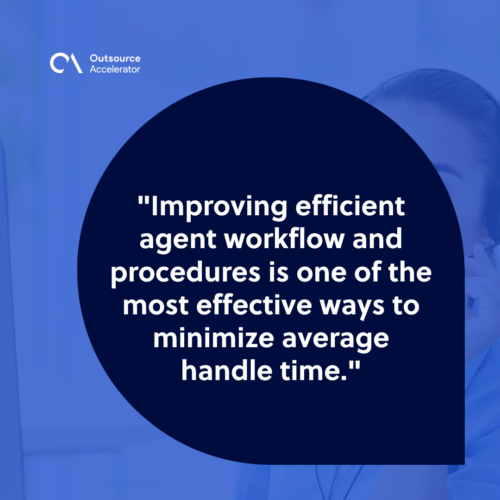Average Handle Time (AHT)
Definition
It is not a good look if a customer experiences long waiting times to have their queries answered. Meanwhile, call center agents have other matters to attend to.
If a customer interaction drags on for too long, it will affect service quality, customer experience, and satisfaction.
This is where we must discuss the importance of average handle time. Continue reading this article to learn more about this metric and how to measure it.
What is Average Handle Time (AHT)?
The Average Handle Time (AHT) is an important metric that calculates how long a customer’s call lasts on average. AHT can be measured weekly, monthly, or quarterly.
Additionally, it was once a key metric for evaluating contact center efficiency when the phone was the primary mode of communication.
Agents and the customer service department are evaluated on their performance using average handle time. AHT can be a helpful indicator for:
- Setting new customer service targets
- Monitoring customer interactions
- Ensuring customer satisfaction
A lower average handling time does not always imply that a call center is operating at its best.
Agents mustn’t pressure consumers off the phone to minimize average handling time, even though they have to do it anyway.
The average talk time should not be excessive. It should be just enough that call center agent performance is not compromised, and the customer has their issues addressed.

How to calculate average handling time?
To figure out your average handle time, add your total talk time, total hold time, and total after-call work, then divide by the total number of calls.
The formula to calculate average handle time looks like this:
[total talk time + total hold time + follow up] / calls = Average Handle Time (calculated in minutes or seconds)
Average handle time accounts for the following:
- Total talk time – This refers to the amount of time your call center agents spend on a customer call.
- Total hold time – It is another simple number to obtain, and it is much more limited than talk time.
- The number of customer calls handled – It is perhaps the most challenging number to assess. Depending on what the contact center holds, the amount of after-call work can vary.
How to minimize average handle time?
Managers of contact centers who want to reduce average handle time can still raise consumer trust and keep call center costs down.
Here are some suggestions on how to improve AHT while avoiding the possibility of agents rushing through a call:
Optimize agent-training
Average handle time can be negatively affected by an untrained contact center agent.
Agents who haven’t had enough training could be more prone to fumbling through calls or going off on tangents, wasting both their and the customer’s time.
Agents that can have a supportive, flexible dialogue while not being too receptive to distractions are critical to a thriving call center.
Contact center leaders can achieve this by implementing agent training to improve agent performance.
Improve call routing
Transferring callers from an agent to another before they meet one who can adequately address their issue is one of the easiest ways to improve average handle time.
With call center software, including ACD, IVR, and skills-based routing, you can dramatically reduce transfers, customer confusion, and call center handling time.
Call parking is another effective way to reduce waiting time and attend to callers more quickly.
Record calls
Call recording software for contact centers is a powerful tool. Both inbound and outbound calls should be recorded.
This allows your customer conversations to be recorded in your internal knowledge base for you to go back to later.
Listen to their call logs when you are unable to track vital needs in real time. When agents have a better understanding of these, they will help identify the best average handle time.
Facilitate the workflow and process
Improving efficient agent workflow and procedures is one of the most effective ways to minimize average handle time.
Removing something that adds to the amount of time handling calls affects call center agent productivity and customer satisfaction scores.
For example, technical support calls may require more time to handle. If an agent is inexperienced in this area, it is best to redirect these calls to someone to decrease average handle time.

Benefits of improving average handle time
Customer satisfaction is the most obvious advantage of better average hold time.
Callers are more satisfied when issues are resolved quickly. Furthermore, improved average hold time boosts contact center performance while lowering costs.
Improves customer satisfaction and loyalty
The shorter the amount of time a customer spends waiting, the better your customer satisfaction score will be. This is one way to enhance customer experience and make them keep coming back.
Improve operational performance
Attending to these calls quickly makes a big difference in productivity and efficiency.
The sooner your support team can handle phone calls and customer queries, the more time you have to focus on other contact center metrics and operations.
Reduce costs
As the old saying goes, time is money. The lower the average handle time, the less money call centers have to shell out for wasted time and additional labor.
Even cutting down the average time spent by a few seconds can make a big financial difference for call centers everywhere.







 Independent
Independent




